Art World
We Decoded the Symbols in New York Governor Andrew Cuomo’s Bizarre New Pandemic Poster, From ‘Boyfriend Cliff’ to That Sinister Octopus
The baffling poster revealed earlier this week is an ode to New York, its citizens, and Cuomo himself.
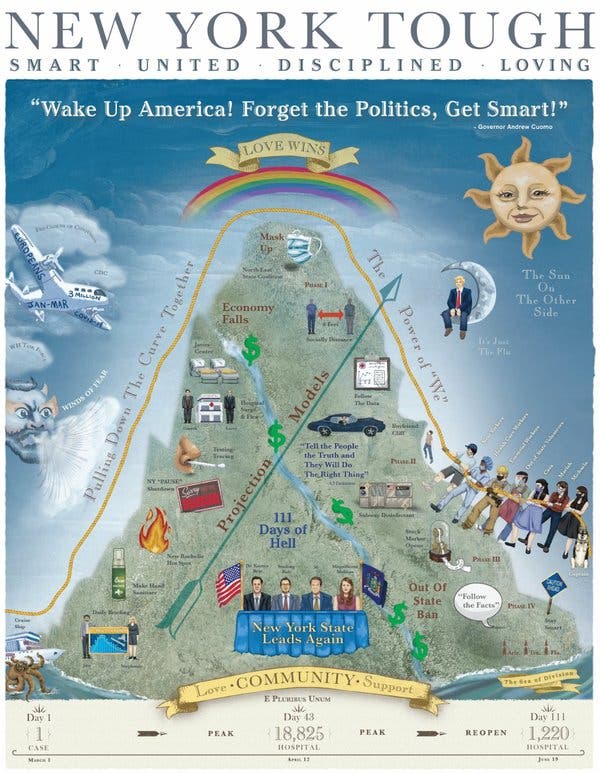
The baffling poster revealed earlier this week is an ode to New York, its citizens, and Cuomo himself.

Katie White

Earlier this week, New York governor Andrew Cuomo debuted a “pandemic poster”—a baffling, retro-styled graphic design of a mountain made in the shape of the state’s coronavirus infection curve. The quizzical image, which is cluttered with emblems and symbols both familiar and obscure to his constituents, has confounded many.
“What is ‘boyfriend cliff’?”, the public wonders at the likeness of a young man clinging to the vertiginous side of the mountain. Also, why is a cartoonishly gargantuan octopus swimming alongside a cruise ship at the image’s bottom lefthand corner?
the "Boyfriend Cliff" is when you date one of Cuomo's daughters and he doesn't like it so he draws you dying on a public poster pic.twitter.com/Ubq8m17veZ
— Katie Sicking (@KatieSicking) July 13, 2020
The poster, which has made quite the media splash, has set off a tizzy of interpretations—and left many scratching their heads. But for those of us whose chosen quarantine hobby hasn’t been baking bread or streaming four workouts a day, but following the governor’s three-month marathon of daily press briefings, this peculiar symbol-stuffed poster isn’t all that surprising, really.
For months, Cuomo has been steering an anxious public through daily slideshows replete with hard facts, personal declarations, charts, historical quotes, and philosophical musings. In that sense, his all-over-the-map poster—which envisions the state’s battle with infection numbers as a sort of medical mountain to overcome—is a perfect distillation of his essence as a leader and public figure. And, in that sense, it’s quite a success.
There is a lot to unpack in this busy, at-times jumbled visual. If you’ve been curious about its inspiration, here’s a breakdown of what’s happening and why.
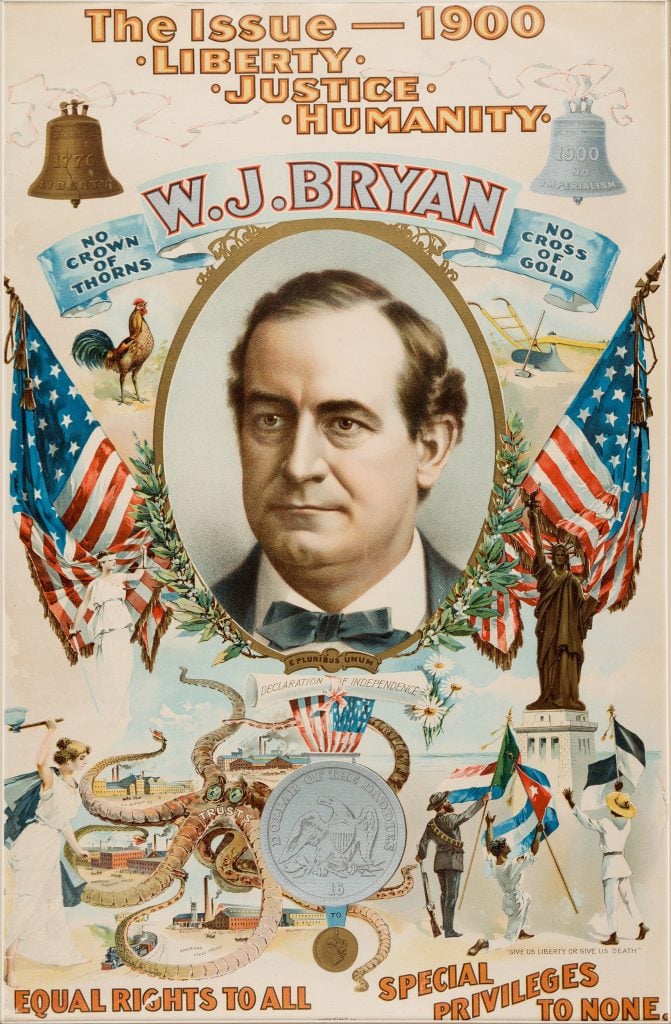
Cuomo’s poster has its precedents in the tradition of political posters, including those of William Jennings Bryan, an American orator and politician from Nebraska. This poster was designed by the Strobridge Lithography Company for the election of 1900. Photo courtesy of the National Portrait Gallery, Smithsonian Institution.
Queens-born Cuomo fancies himself something of a Renaissance man—“Father, fisherman, motorcycle enthusiast, 56th Governor of New York,” his Twitter bio reads. He is also an unabashed history buff, with a passion for the tradition of campaign posters and their fanciful, visual storytelling. Some have rightly noted, the influence of the political posters of William Jennings Bryan, an American orator and Nebraska politician, on Cuomo’s most recent creation.
Mount Coronavirus is not the governor’s first foray into the world of glorifying poster art. In January, he debuted his “Ship of State,” a vintage-inspired nautical-psychedelic vision of the state in its third term under his leadership—a masterpiece made with the help of Brooklyn artist Rusty Zimmerman, who has manifested Cuomo’s vision in three previous posters. (Zimmerman is not the artist behind this latest masterpiece, however. The artist has yet to be revealed).
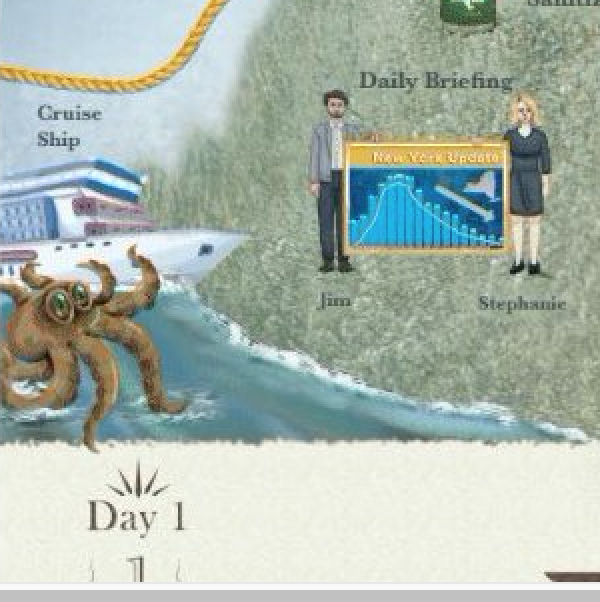
Detail of on an octopus approaching Mount Coronavirus.
Though an octopus sidling up next to a cruise ship (one may presume one of the many cruise ships ravaged by the virus) may not seem intuitive—the eight-limbed mollusk actually has a fraught, even sinister, significance in nautical tradition and the history of map-making.
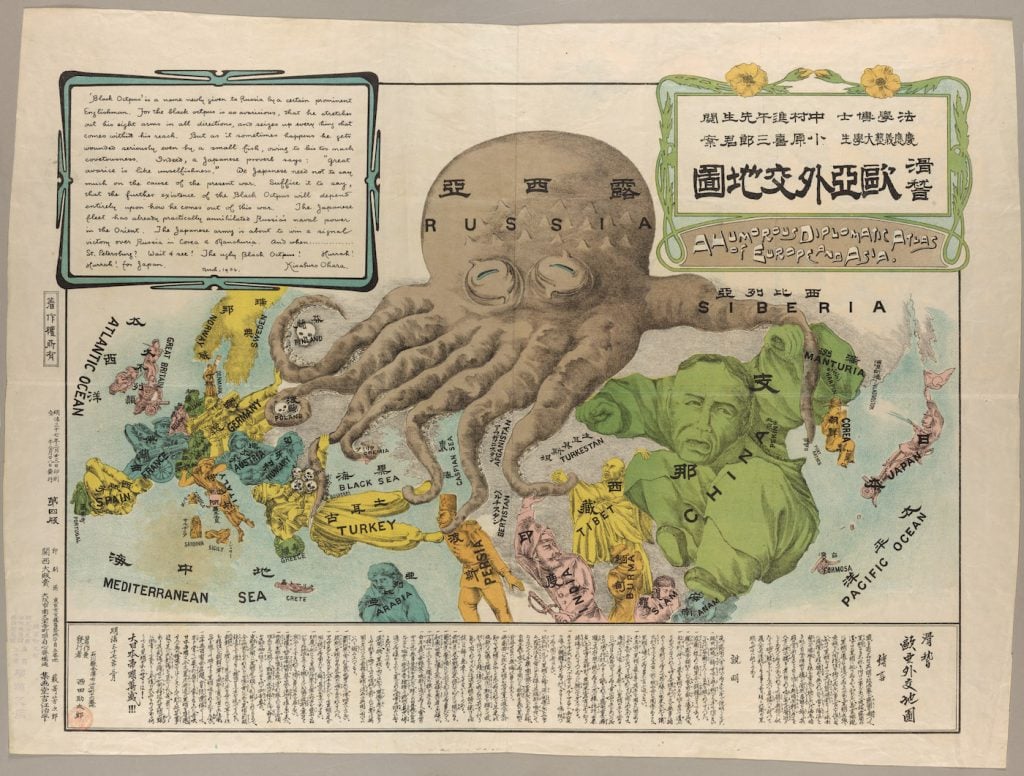
Kisaburō Ohara, “A Humorous Diplomatic Atlas of Europe and Asia” (1904), an anti-Russian map created by a Japanese student at Keio University during the Russo-Japanese War. Courtesy of Persuasive Maps: PJ Mode Collection, Cornell University Library.
With its numerous limbs, the sea creature came to symbolize a dexterous and tricky enemy. Above, in William Jennings Bryan’s poster, the politician has labeled his octopus “trusts.” What’s more, the 19th-century the octopus was often added to propaganda maps to symbolize nefarious land grabs by nations. In this case, we might consider the creature to signify the little understood and lethal virus.
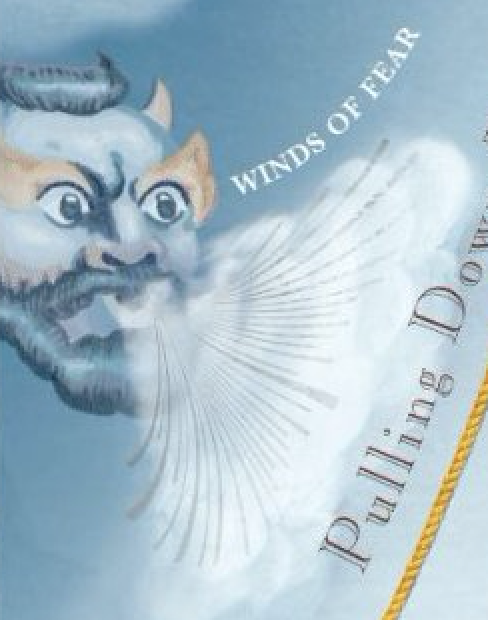
Personified “Winds of Fear.”
The poster’s personified “Winds of Fear” (along with the correlating smiling, and possibly leering sun of tomorrow) has stirred great consternation. But here again, Cuomo’s poster makes reference to historical maps. Dating back centuries, the four compass winds were frequently added to maps in the guise of floating heads.
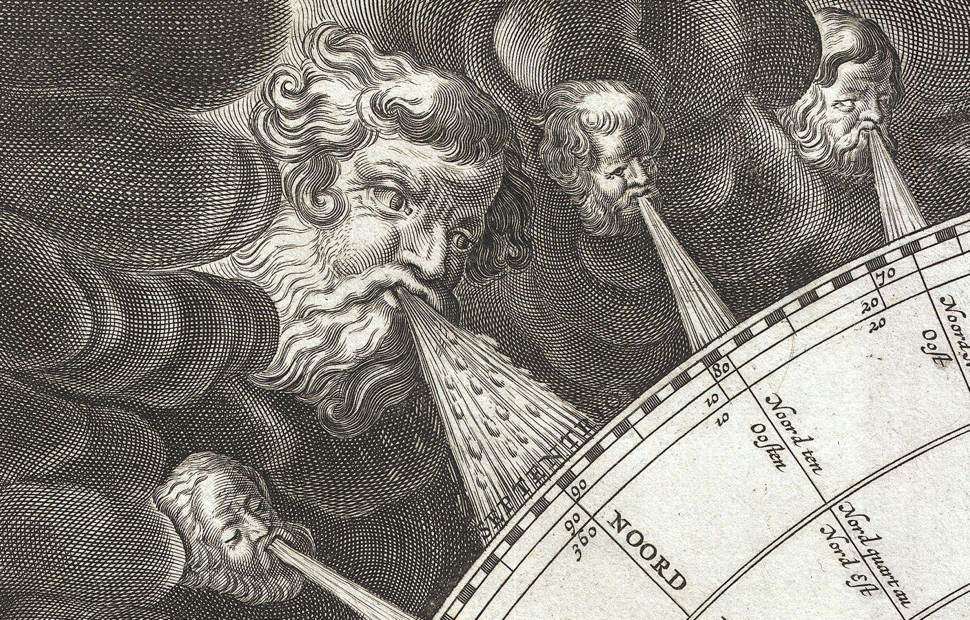
Jan Jansson, Map of the Winds (1650).
This tradition has its roots in the ancient Mediterranean world, in which the four mythical cardinal winds were personified as gods, known as the Anemoi.
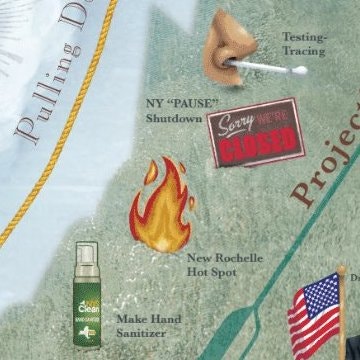
The New Rochelle “Hot Spot” flanked by hand sanitizer and “NY Pause.”
Some have noted the map’s similarities to 19th-century Christian prints of redemption and salvation (often replete with a journey up and down a mountaintop). Here, the near Biblical imagery continues, as the governor’s map marks the state’s first cluster of cases in the Westchester city of New Rochelle with a hellish burning flame (“111 Days of Hell” is unsubtly written across the poster too). Flanking the flame are markers to the state’s timeline of response, including the mask order and the state’s manufacture of hand-sanitizer or “little visuals of what was going on,” as Cuomo said in a press brief.
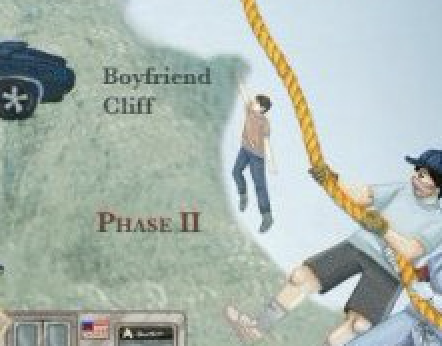
Detail of “Boyfriend Cliff” in Cuomo’s pandemic poster.
“Boyfriend Cliff” is trending on social media, and that’s because, yes, part of this strange geography is a young man pictured dangling on the mountainside. While decoding Cuomo’s iconology can feel akin to reading hieroglyphics—devotees to his press conferences will have a conjecture: Cuomo has made his fair share of dad jokes about romance over quarantine. When he introduced Zoom weddings he projected that more couples would actually be splitting up than locking it down after months trapped together indoors, leading some to believe “boyfriend cliff” is a relationship hanging on for dear life.
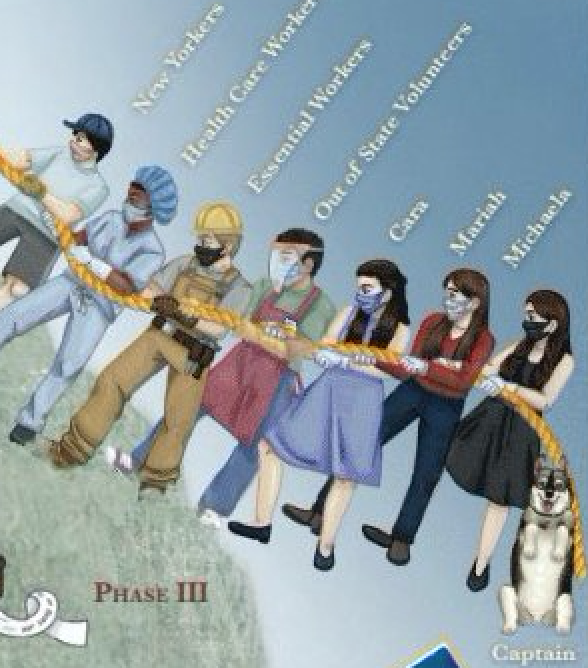
Cuomo’s three daughters, Cara, Mariah, and Michaela, and dog Capitain helping to pull down the curve.
But more likely than not the cliff has more to do with Cuomo’s own brood and the introduction of his daughter Mariah’s boyfriend into the familial quarantine (please enjoy this awkward photo of Sunday dinner). “I like the boyfriend,” the governor has frequently mused with a comically suspect inflection.
Even Chrissy Teigen weighed in on “boyfriend cliff” via Twitter, prompting Cuomo to respond:
We do like the boyfriend. All boyfriends face a steep climb. https://t.co/y7HBhnxcrx
— Andrew Cuomo (@NYGovCuomo) July 13, 2020
Furthering the theory that “boyfriend cliff” reflects the precariousness of young love, Cuomo’s youngest daughter, 22-year-old Michaela Kennedy-Cuomo, gave more credence to the idea, tweeting, “There’s more room for significant others on #boyfriendcliff.”
All three Cuomo daughters—Mariah, Cara, and Michaela—make appearances in the poster, helping to pull down the curve along with doctors, volunteers, and healthcare workers—as well as the governor’s dog, Captain.
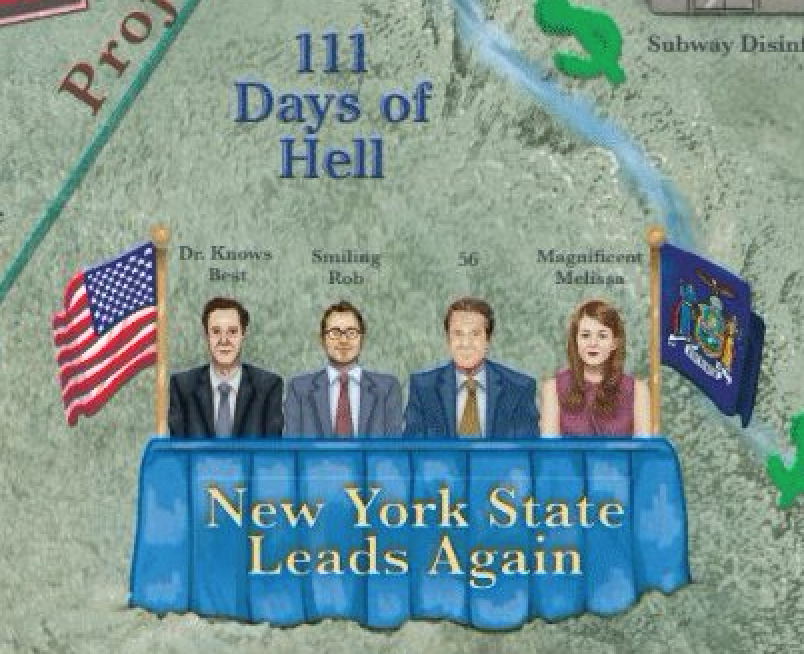
Cuomo and his daily press conference team.
At its essence, is the poster an ode to Cuomo’s daily press briefings, when he was master of a rapt audience, providing comfort in chaos? Perhaps. Cuomo certainly commemorates his press briefing here, with renderings of his advisors, including “Magnificent Melissa” (Melissa DeRosa), the quick-witted secretary to the governor.
And who could forget the governor’s many catchphrases? With this poster, no one, since they all make appearances in a wild assault of typefaces. We’ve got “New York Tough” and “Smart, United, Disciplined and Loving” and the unwittingly crass “Surge and Flex.” Cuomo even quotes himself with his favorite no-nonsense refrain, “Wake Up America! Forget the Politics! Get Smart!”

A quote from made-up character AJ Parkinson.
If you’re not familiar with AJ Parkinson, Cuomo’s oft-quoted thinker, it’s because Parkinson is made-up. The character was created by former governor Mario Cuomo, and Cuomo the younger keeps up the honestly bizarre tradition of quoting Parkinson’s wisdom to this day.

The rainbow beaming above Mount Coronavirus.
Under a golden “Love Wins” banner, a rainbow appears shining out just above the mountain. Some have suggested that it references the Gay Pride flag (perhaps because Cuomo quite proudly passed the state’s marriage equality bill). But in all likelihood, the rainbow embodies numerous interpretations. Cuomo included a rainbow at the top of his last poster with the words “moral arc of the universe.”
The rainbow is certainly meant as a sign of hope. In Western art history, the rainbow often alludes to the story of Noah’s Ark. When the floods finally subsided, God sent the rainbow as a symbol that he would never again destroy the world with a flood.
Interestingly, during the pandemic, rainbows have become an oft-used motif by children making drawings to thank first responders. Placed on windows and front doors, the rainbow drawings have been a way of connecting with neighbors from a distance—and are meant as reminders that sunshine often follows a storm.